


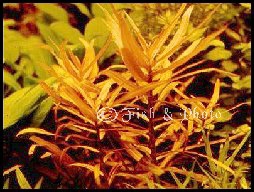
![]() ...Ammannia
gracilis
...Ammannia
gracilis
![]() .Ludwigia
glandulosa
.Ludwigia
glandulosa
![]() ..Ludwigia
arcuata.
..Ludwigia
arcuata.
Ludwigia repens x L .arcuata.![]()
Ammannia senegalensis..![]()
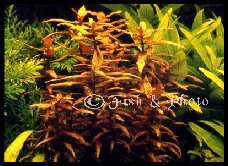
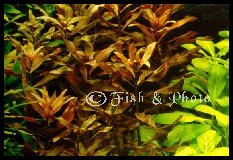
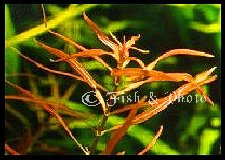
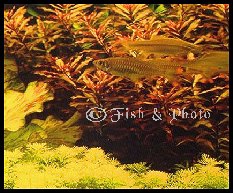
   | ||
| Red
plants in the architectoc aquarium 2 | ||
 |
|
 |
 |
 |
 |
| Ammannia,
a marsh plant line belonging to the family of the Lythraceae or Cattail alikes
of which up until now two sorts have proved to be excellent suitable for the culture
in an aquarium milieu. Both types desire the same treatment, where A. senegalensis
has appeared to be the most sensitive one. In a lot of cases the plants remain
green or only the top colors orange, after that it grows more slowly, the leaves
near the bottom become black and fall down. Cause: in our opinion it must be searched
in the first place in the lack of light. But also the composition of the water
is very important. Both plants appreciate to a considerable plash of light where
as the temperature can be a little higher. They grow best in gently and slightly
acid water. In water with a few higher KH (5 - 8) the growth indeed is a little
bit slower, but the color becomes warmer and more intense. That impact can also
be reached in gently acid water by putting some broken shells or chalk in the
bottom at the roots. New slips must be brought on length with a sharp knife directly
under a button; one must prevent to squeeze the stem. This will result in stagnation
of the growth during longer time. Place them on wide distance of each other in
a loose bottom of e.g. not washed river sand Addition of a some peat and clay is recommended. Water quality gives no problems for this type. Ammannia gracilis, the giant- Ammannia, has been introduced in the Netherlands by the flying aquarist P.J. Bussink, who brought it with him from Liberia. In nature they would occur as marsh plants. |
Of these two attractive plants, Ammannia senegalensis, the congnacplant, has been
known for the longest time. These type remains a little smaller and slender then
the previous type. At first A. senegalsis was a very popular aquarium plant but
they rapidly were already repressed by the later imported and according to some
much more beautiful A. gracilis. But that is a question of taste and I assume
that A. senegalsis has lost the competition because the culture is just a little
more cumbersome. It is characteristic the leaves which stand two to two crosswise
to the stem. Especially the leaves at the bottom are curling down a little in
a typical way. Also the red color inclined to brown, which gave the plant its
Dutch name, makes it uncomplicated to differentiate it from the A.gracilis. She
comes from Africa as well. There she grows submerse |